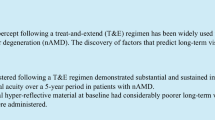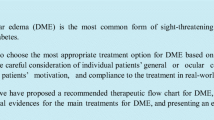Abstract
Purpose
To determine the characteristics of eyes with treatment-naïve quiescent choroidal neovascularization (CNV) detected by optical coherence tomography angiography (OCTA).
Methods
Thirty-eight eyes of 37 treatment-naïve consecutive patients (30 men, 7 women, average 69.8 years) were studied. Quiescent CNVs were detected by OCTA (RTVue XR Avanti, Optovue, Fremont, CA) in all eyes. Swept-source OCT (SS-OCT; DRI-OCT, Topcon, Japan) confirmed the absence of exudation. The symptoms, visual acuity, CNV size, and status of the fellow eye were evaluated. Patients were followed longitudinally and the length of follow-up period and development of exudation were recorded for each patient. We also investigated patients’ medical records from their referral hospitals in search of prior exudation.
Results
All eyes with quiescent CNV were diagnosed at the initial visit with sub-retinal pigment epithelium CNVs, i.e., type 1 CNV, from the OCT and OCTA images. Prior exudation was confirmed in 15 eyes (39.5%) from their medical records of the referral hospitals. Symptoms were present in 18 eyes (47.3%). An exudative CNV was present in 12 of the fellow eyes. Exudation developed in 12 eyes (31.6%) during an average follow-up period of 25.1 months. One-half of the eyes had a prior exudation. The CNV at the baseline in eyes that developed exudation during the follow-up period was larger than eyes without exudation; however, the difference was not significant (0.59±0.47 vs 0.48±0.32 mm2, P = 0.50).
Conclusion
Quiescent CNVs will develop exudation in approximately 30% of the eyes during a mean 2-year follow-up period. These findings must be remembered when investigating quiescent CNVs that could not be distinguished from eyes with former active CNV and naturally deactivate CNV.


Similar content being viewed by others
References
Savastano MC, Lumbroso B, Rispoli M (2015) In vivo characterization of retinal vascularization morphology using optical coherence tomography angiography. Retina 35:2196–2203
Spaide RF, Klancnik JM Jr, Cooney MJ (2015) Retinal vascular layers imaged by fluorescein angiography and optical coherence tomography angiography. JAMA Ophthalmol 133:45–50
Spaide RF (2015) Optical coherence tomography angiography signs of vascular abnormalization with antiangiogenic therapy for choroidal neovascularization. Am J Ophthalmol 160:6–16
Nehemy MB, Brocchi DN, Veloso CE (2015) Optical coherence tomography angiography imaging of quiescent choroidal neovascularization in age-related macular degeneration. Ophthalmic Surg Lasers Imaging Retina 46:1056–1057
Carnevali A, Cicinelli MV, Capuano V et al (2016) Optical coherence tomography angiography: a useful tool for diagnosis of treatment-naïve quiescent choroidal neovascularization. Am J Ophthalmol 169:189–198
Laiginhas R, Yang J, Rosenfeld PJ, Falcão M (2020) Nonexudative macular neovascularization - a systematic review of prevalence, natural history, and recent insights from OCT angiography. Ophthalmol Retina 4:651–661
Kanda Y (2013) Investigation of the freely available easy-to-use software ‘EZR’ for medical statistics. Bone Marrow Transplant 48:452–458
Querques G, Srour M, Massamba N et al (2013) Functional characterization and multimodal imaging of treatment-naive “quiescent” choroidal neovascularization. Invest Ophthalmol Vis Sci 54:6886–6892
de Oliveira Dias JR, Zhang Q, Garcia JMB et al (2017) Natural history of subclinical neovascularization in nonexudative age-related macular degeneration using swept-source OCT angiography. Ophthalmology 125:255e266
Yang J, Zhang Q, Motulsky EH et al (2019) Two-year risk of exudation in eyes with non-exudative AMD and subclinical neovascularization detected with swept source OCT angiography. Am J Ophthalmol 208:1e11
Bailey ST, Thaware O, Wang J et al (2019) Detection of nonexudative choroidal neovascularization and progression to exudative choroidal neovascularization using OCT Angiography. Ophthalmol Retina 3:629e636
Solecki L, Loganadane P, Gauthier AS et al (2020) Predictive factors for exudation of quiescent choroidal neovessels detected by OCT angiography in the fellow eyes of eyes treated for a neovascular age-related macular degeneration. Eye (Lond) Epub ahead of print.
Wong TY, Chakravarthy U, Klein R et al (2008) The natural history and prognosis of neovascular age-related macular degeneration: a systematic review of the literature and meta-analysis. Ophthalmology 115:116–126
Polito A, Isola M, Lanzetta P et al (2006) The natural history of occult choroidal neovascularisation associated with age-related macular degeneration. A systematic review. Ann Acad Med Singapore 35:145–150
Acknowledgements
The authors thank Professor Emeritus Duco Hamasaki of the Bascom Palmer Eye Institute, University of Miami, for his critical discussion and editing of the revised manuscript.
Author information
Authors and Affiliations
Corresponding author
Ethics declarations
Ethical approval
All procedures performed in studies involving human participants were in accordance with the ethical standards of the Institutional Review Board of the Tokyo Women’s Medical University and with the 1964 Helsinki declaration and its later amendments or comparable ethical standards.
Informed consent
Informed consent was obtained from all individual participants included in the study.
Conflict of interest
Dr. Fukushima has nothing to disclose. Dr. Maruko reports grants from JSPS KAKENHI (Grant Number JP 20K09781), grants and personal fees from Alcon Pharma K.K., personal fees from Bayer Yakuhin, Ltd., personal fees from Santen Pharmaceutical Inc., personal fees from Alcon Japan, Ltd., personal fees from Topcon Co., Ltd., personal fees from Senju Pharmaceutical Co., Ltd., and personal fees from NIDEK Co., Ltd., outside the submitted work. Dr. Chujo has nothing to disclose. Dr. Hasegawa has nothing to disclose. Dr. Arakawa has nothing to disclose. Dr. Iida reports grants and personal fees from Alcon Pharma K.K. (Japan), personal fees from Bayer Yakuhin, Ltd. (Japan), grants and personal fees from Santen Pharmaceutical Co., Ltd. (japan), grants from Nidek (Japan), grants from Senju Seiyaku (Japan), research support from Canon (Japan), research support from Kowa (Japan), and research support from Topcon (Japan), outside the submitted work.
Additional information
Publisher’s note
Springer Nature remains neutral with regard to jurisdictional claims in published maps and institutional affiliations.
Rights and permissions
About this article
Cite this article
Fukushima, A., Maruko, I., Chujo, K. et al. Characteristics of treatment-naïve quiescent choroidal neovascularization detected by optical coherence tomography angiography in patients with age-related macular degeneration. Graefes Arch Clin Exp Ophthalmol 259, 2671–2677 (2021). https://doi.org/10.1007/s00417-021-05127-x
Received:
Revised:
Accepted:
Published:
Issue Date:
DOI: https://doi.org/10.1007/s00417-021-05127-x




